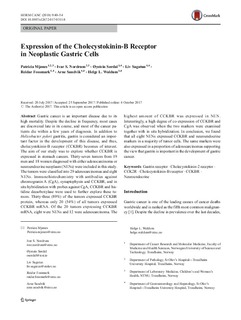| dc.contributor.author | Mjønes, Patricia | |
| dc.contributor.author | Nordrum, Ivar Skjåk | |
| dc.contributor.author | Sørdal, Øystein Finset | |
| dc.contributor.author | Sagatun, Liv | |
| dc.contributor.author | Fossmark, Reidar | |
| dc.contributor.author | Sandvik, Arne Kristian | |
| dc.contributor.author | Waldum, Helge | |
| dc.date.accessioned | 2018-02-27T09:16:31Z | |
| dc.date.available | 2018-02-27T09:16:31Z | |
| dc.date.created | 2017-10-11T14:50:03Z | |
| dc.date.issued | 2017 | |
| dc.identifier.citation | Hormones and Cancer. 2017, 9 40-54. | nb_NO |
| dc.identifier.issn | 1868-8500 | |
| dc.identifier.uri | http://hdl.handle.net/11250/2487249 | |
| dc.description.abstract | Gastric cancer is an important disease due to its high mortality. Despite the decline in frequency, most cases are discovered late in its course, and most of the cancer patients die within a few years of diagnosis. In addition to Helicobacter pylori gastritis, gastrin is considered an important factor in the development of this disease, and thus, cholecystokinin-B receptor (CCKBR) becomes of interest. The aim of our study was to explore whether CCKBR is expressed in stomach cancers. Thirty-seven tumors from 19 men and 18 women diagnosed with either adenocarcinoma or neuroendocrine neoplasm (NENs) were included in this study. The tumors were classified into 29 adenocarcinomas and eight NENs. Immunohistochemistry with antibodies against chromogranin A (CgA), synaptophysin and CCKBR, and in situ hybridization with probes against CgA, CCKBR and histidine decarboxylase were used to further explore these tumors. Thirty-three (89%) of the tumors expressed CCKBR protein, whereas only 20 (54%) of all tumors expressed CCKBR mRNA. Of the 20 tumors expressing CCKBR mRNA, eight were NENs and 12 were adenocarcinoma. The highest amount of CCKBR was expressed in NEN. Interestingly, a high degree of co-expression of CCKBR and CgA was observed when the two markers were examined together with in situ hybridization. In conclusion, we found that all eight NENs expressed CCKBR and neuroendocrine markers in a majority of tumor cells. The same markers were also expressed in a proportion of adenocarcinomas supporting the view that gastrin is important in the development of gastric cancer. | nb_NO |
| dc.language.iso | eng | nb_NO |
| dc.publisher | Springer Verlag | nb_NO |
| dc.rights | Navngivelse 4.0 Internasjonal | * |
| dc.rights.uri | http://creativecommons.org/licenses/by/4.0/deed.no | * |
| dc.title | Expression of the Cholecystokinin-B Receptor in Neoplastic Gastric Cells | nb_NO |
| dc.type | Journal article | nb_NO |
| dc.description.version | publishedVersion | nb_NO |
| dc.source.pagenumber | 40-54 | nb_NO |
| dc.source.volume | 9 | nb_NO |
| dc.source.journal | Hormones and Cancer | nb_NO |
| dc.identifier.doi | 10.1007/s12672-017-0311-8 | |
| dc.identifier.cristin | 1503849 | |
| dc.description.localcode | © The Author(s) 2017. Open Access. This article is distributed under the terms of the Creative Commons Attribution 4.0 International License (http://creativecommons.org/licenses/by/4.0/). | nb_NO |
| cristin.unitcode | 194,65,15,0 | |
| cristin.unitcode | 194,65,1,0 | |
| cristin.unitname | Institutt for klinisk og molekylær medisin | |
| cristin.unitname | MH fakultetsadministrasjon | |
| cristin.ispublished | true | |
| cristin.fulltext | preprint | |
| cristin.fulltext | original | |

